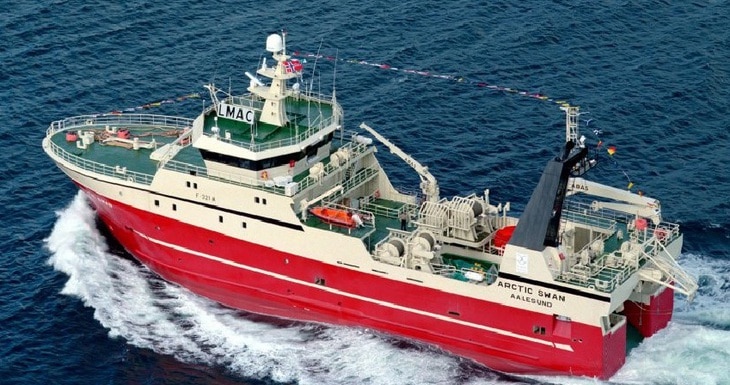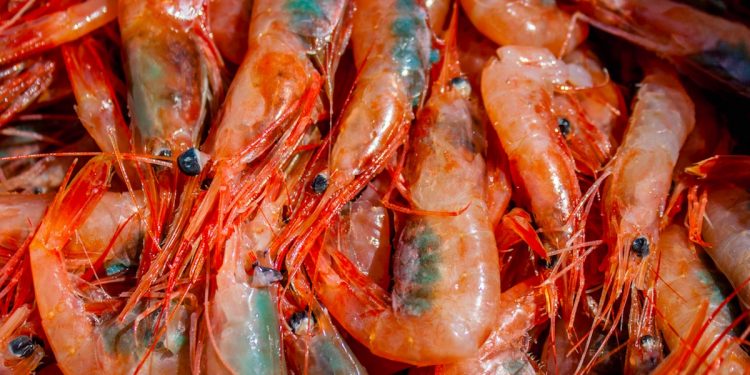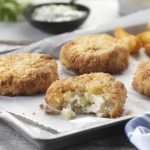Issues close to home, a fudged report and a policy designed to deter outsiders are the highlights of a complex situation in which the Norwegian authorities appear to be pursuing one policy in home waters and a diametrically opposite course in international waters where the EU shrimp fleet is mainly active.
Norway’s proposal is to ban the use of combination gear that separates catches of shrimp and fish, presenting a report to NEAFC to support its case that sparks more questions than it answers.
The proposal would outlaw the use of upper codends (also referred to as ‘collecting bags’) regardless of the mesh size used by the EU trawlers fishing for shrimp. The mesh size in collecting bag codends has ranged from 130-155mm depending on vessels. These have been is use for a number of years in Skagerak, North Sea, Icelandic, Norwegian and NEAFC waters, but the Norwegian proposal claims that this method results in a risk of juvenile fish being caught when applied to the international waters of the NEAFC zone.

The questions arise over the data presented by the Norwegian Directorate of Fisheries to back its case. The data was collected on board two Norwegian trawlers working on these grounds, Remøy and Arctic Swan. The collecting bag gear is reported to have been made on board by the crews, and catch sampling was also carried out by the crew, concentrating on measurements taken from the first fish from each haul to come out of the reception pound instead of the usual approach of selecting fish from across an entire haul.
Among other oddities, there are significant discrepancies between the data from the two trawlers, including that the report refers to catches of Greenland halibut, cod and small quantities of haddock, but there is no mention of American plaice which would normally be a significant part of catch composition on these fishing areas.
According to the report, Remøy’s collecting bag was made in 155mm mesh, while Arctic Swan’s was in 140mm netting. While it would be logical for Remøy to therefore have smaller amounts of juvenile in the collecting bag, this is in fact apparently not the case.
As one industry figure put it, the report’s main finding seems to be that the smaller the mesh in the codend, the less undersized fish can be expected to be caught.
The Institute of Marine Research is believed to have declined to be associated with the report, produced with little scientific rigour, and using gear for which there appears to be no schematic drawing. Fiskerforum approached the Institute, which has neither confirmed nor denied that it had been asked to verify the report – which is marked only as having been produced by the Directorate of Fisheries.
In Norway’s home waters, collecting bags are widely used by shrimp trawlers and have been for many years. Fisheries Minister Harald T Nesvik has responded to the complaints from coastal fishermen by lifting requirements for coastal shrimp trawlers to use a sorting grid and collecting bag, effectively reducing selectivity of shrimp trawl gear used by trawlers that land catches for sale fresh at the quayside. Norwegian shrimp trawlers have therefore started to take groundfish catches in domestic waters into shrimp codends with 38-40mm mesh. At the same time the Norwegian position is that there is too much risk of juvenile fish being caught by the EU shrimp fleet in NEAFC waters using 130-155 mesh netting of collecting bags combined with sorting grids.

The proposal at NEAFC to end the use of collecting bags has been seen as a direct attack on the EU fishing vessels operating in international waters, participating in an MSC-certified fishery, and this conflicts uncomfortably with the relaxation of requirements in home waters – just as North Sea cod has lost its MSC certification.
The Estonian Long Distance Fishing Association (ELDFA) has pointed out in a dialogue with the European Commission that the EU fleet relies on fishing with combination gear.
‘The true motivation of the oil driven states of Russia and Norway is unknown but their attempts to minimise EU’s fishing effort in the international waters of NEAFC zone Ia is known. At least it has nothing to do with preservation of fish stock or making the bottom trawling effort more sustainable. The EU shrimp fleet has quotas for both its shrimp and fish catches. From an environmental point of view, it makes perfect sense to fish groundfish quotas in 130-155mm mesh codends while trawling for shrimp using sorting grids. The carbon footprint of the groundfish catch is practically zero and it obviously increases emissions from fishing if vessels have to trawl separately the same groundfish,’ ELDFA states in its communication with the European Commission.
‘The most worrying aspect of Norway’s proposal is not suggesting a ban on others while promoting the very same in home waters. The misuse of the data gathered in the ‘experimental’ fishing by the two Norwegian trawlers is much more serious. The Norwegian Ministry knows the data is unproductive, their Institute of Marine Research does not want to have anything to do with it and still they present misleading findings from this biased data in an international forum like NEAFC to support their proposal. Norway’s behaviour undermines the scientific approach to fisheries management in international waters and that is by far the most worrying aspect of their proposal,’ ELDFA commented.









